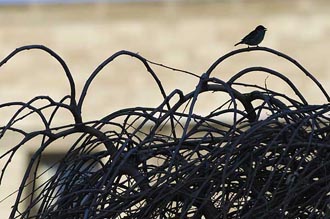Bird song app identifies feathered friends by tweets
UPDATE: Making a top-flight bird call identification app is tougher than it sounds, according to Mark Berres, developer of WeBIRD. While the project did not reach the public in spring of 2012, as Berres hoped, he says the app is on track to a release in time for the North American migration in early 2013. If you have further questions, please direct them to Chris Barncard, barncard@wisc.edu.
Squinting into wind-blown trees and bushes is for the birds, especially if it’s the birds you’re looking for.
“You have to listen. There’s no way around it,” says Mark Berres, a University of Wisconsin–Madison ornithologist. “The most difficult aspect of bird-watching is call identification, but calls are the most important tool for identifying birds.”

A new smartphone app will help identify birds, like this one photographed in the Allen Centennial Garden, by their songs.
Photo: Jeff Miller
Even the most experienced birders have trouble matching more than a handful of songs with species, but by melding his background in our feathered friends, teaching and genetics, Berres may have answered the prayers of bird-watchers, researchers and even the most casual naturalist.
Naturally, salvation comes in the form of a smartphone app. And naturally — for a university professor — the inspiration started with a graduate student, one that stepped into Berres’ office a few years ago to show off a nifty iPhone trick.
“He recorded a short bit of music coming from the radio in my office, tapped an ‘identify’ button, and in a few seconds it told him the name of the song we’re listening to,” Berres says. “Right away, I thought, ‘We can use this for birds.’”
For more than a year, Berres (and his graduate students, of course) have been testing and improving the fruit of that inspiration: WeBIRD, the Wisconsin Electronic Bird Identification Resource Database.
Like music-identification apps Shazam and MusicID, WeBIRD allows anyone with a smartphone and a mysterious bird nearby to record the bird’s call, submit it wirelessly to a server and (after a few seconds) receive a positive ID on the species of bird tweeting away within earshot.
“I am amazed at how good it is,” says Berres, who has also used WeBIRD to identify grasshopper species by their clicking calls and frogs by their croaks. “In fact, not only can WeBIRD tell you which species you’re hearing, it’s good enough to identify individual birds from their song.”
For birders, the former qualifies as a reason to rejoice. For researchers, the latter could change the nature of field studies. For the birds, WeBIRD — which hopes to make available to the public in time for the spring migration in 2012 — could be a lifesaver.
Any way to deepen the ties between people and their natural surroundings is a helpful step toward conservation.
“If people can appreciate intrinsic beauty — and birds have got that part down — a closer awareness of the natural world will follow,” Berres says. “Fostering a connection with wildlife is one of the ways we’re going to save it, and WeBIRD puts that connection to birds in the palm of your hand.”
Accurate automated analysis of recorded songs could help researchers track the comings and goings of flocks and individuals. Instead of sending students and scientists out into the wild to collect data — collection that could be hindered by variations in hearing, fatigue, biting insects and the very presence of a human being — a research team could venture out periodically to collect recordings of research plots and analyze the results with WeBIRD.
To place a bird call with its species is a chore far more complicated than the music-matching apps.
“Their problem of comparing a high-quality reproduction to the original is really a fairly easy one,” Berres says.
Analyzing bird calls, on the other hand, is a little like trying to match a live cover of “Bridge Over Troubled Water” to the version Simon and Garfunkel recorded for their 1970 album.
“When a bird sings, the song itself may have varying amplitudes and frequencies,” Berres says. “It can also speed up a little bit, slow down a little bit. They may throw in a note here or take out a note there.”
Birds also differ their calls throughout the day. And a bird of a particular species on UW–Madison’s lakeside campus may develop an accent of sorts, distinct from birds of the same species living just a few miles away at the UW Arboretum.
The WeBIRD algorithm dices bird calls into time-ordered chunks of frequency and energy, using data-organization techniques more often applied by geneticists to jumbled bits of DNA geneticists to “align temporally misaligned data, working around a lot of the variation,” Berres said.
The data-handling trick practically puts Berres himself — who knows his birds, and expects his ornithology students to learn 140 calls — in your pocket.
“When I’m out in the field, I can interact with the students,” says Berres, who will put students to work testing WeBIRD in fall ornithology courses. “I can say, ‘Stop. Listen to that. What is it? And how do you know that?’ But what do you do when the instructor isn’t there?”
Or if you are your own instructor?
“With an app like this, you can get confirmation of what you think you’re hearing along with pictures and videos and range maps for the birds in your backyard or the park,” Berres says. “You’ll learn more about the world around you, and there’s nothing but good in that.”
